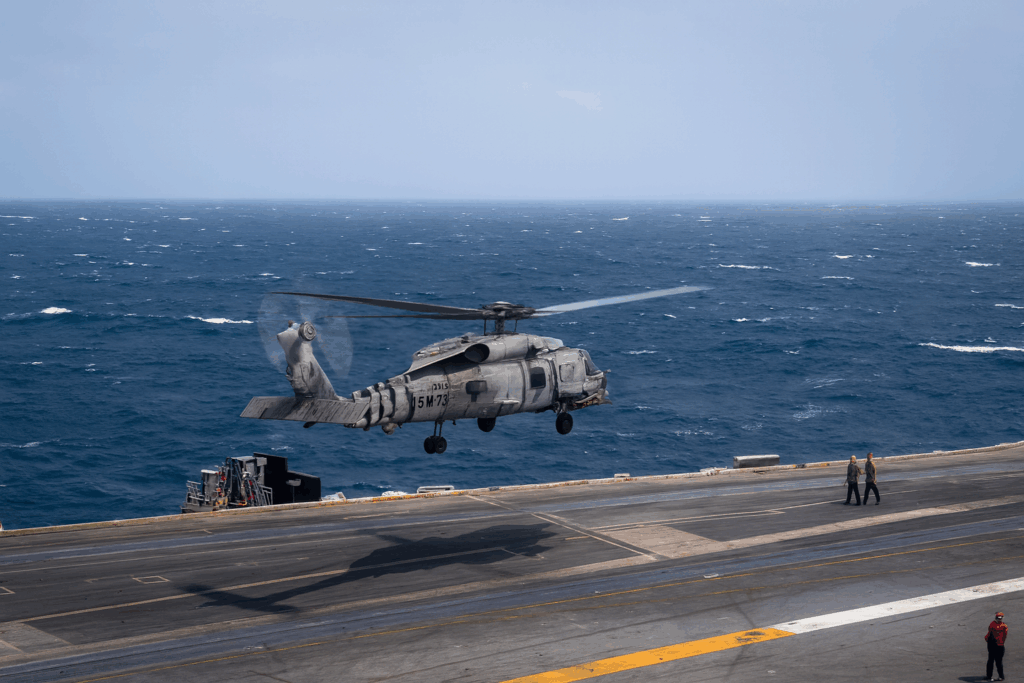In an unusual pair of aviation mishaps, a U.S. Navy helicopter and a fighter jet both crashed within 30 minutes of each other on Sunday. The crashes happened during separate routine operations over the South China Sea. All five crew members were rescued and are in stable condition, the Navy said. Officials opened a dual investigation into what went wrong.
The U.S. Pacific Fleet — the Navy’s largest operational command — confirmed that the two aircraft crashed in international waters. These waters have become a persistent source of tension between Washington and Beijing. Both aircraft were operating from the USS Nimitz (CVN-68).
“The cause of the incidents remains under investigation,” the Pacific Fleet said in a statement. “All personnel have been safely recovered and are in stable condition.”
Two Crashes, One Carrier
The first crash occurred at about 2:45 p.m. local time. An MH-60R Seahawk helicopter assigned to the “Battle Cats” of Helicopter Maritime Strike Squadron 73 went down during routine operations from the carrier. Search-and-rescue teams from Carrier Strike Group 11 quickly launched, located, and recovered all three crew members.
About half an hour later, an F/A-18F Super Hornet from the “Fighting Redcocks” of Strike Fighter Squadron 22 also crashed while operating from the Nimitz. Both aviators ejected safely and were retrieved from the sea minutes later. “Swift action from the strike group ensured everyone made it home alive,” a Navy official told Reuters.
The Pacific Fleet said flight operations from the Nimitz have resumed. The Navy is conducting parallel investigations into both incidents. Officials declined to speculate on potential causes, citing ongoing data collection and mechanical inspections aboard the carrier.
Trump Calls Incidents ‘Very Unusual’
President Donald Trump, en route from Malaysia to Japan on Air Force One, called the near-simultaneous crashes “very unusual” and suggested that investigators were looking into possible fuel contamination.
“They think it might be bad fuel,” Trump told reporters Monday. “We’re gonna find out. Nothing to hide, sir.” He added that he did not believe any foul play was involved but wanted “a full accounting” from the Navy.
The accidents occurred as Trump continues his Asia tour. He has meetings planned this week with Chinese President Xi Jinping. The timing of the mishaps, over waters long disputed by China and its neighbors, adds an unexpected wrinkle to sensitive diplomatic exchanges.
Strategic Waters, Growing Tensions
The South China Sea is a vital shipping route bordered by China, Vietnam, Malaysia, and the Philippines. It has become a flashpoint for global competition. China claims almost all of the 1.3 million-square-mile waterway, despite a 2016 international tribunal ruling that invalidated Beijing’s sweeping assertions.
In recent years, China has militarized artificial islands across the sea. It has built runways, radar systems, and missile installations to reinforce its claims. The U.S. maintains regular “freedom of navigation” operations to challenge those claims and demonstrate support for regional allies.
At a Monday briefing, Chinese Foreign Ministry spokesperson Guo Jiakun said Beijing would provide humanitarian aid if the U.S. requests it. He also criticized Washington’s frequent military displays, saying they increase the risk to regional peace.
Aging Fleet, Repeated Mishaps
The F/A-18F lost Sunday was at least the fourth Super Hornet the Navy has lost in 2025. Three earlier crashes happened — two in the Red Sea and one off Virginia during a training exercise. Each jet is valued at about $60 million.
The USS Nimitz, commissioned in 1975, is the Navy’s oldest active carrier. It is one of the largest warships in the world. The ship is expected to retire in 2026 after over five decades of service. Its history includes a role in the failed 1980 Operation Eagle Claw rescue mission in Iran.
Naval analysts say the twin crashes raise concerns about maintenance and logistics on aging platforms. “These back-to-back losses underscore the strain of continuous operations in contested regions,” said maritime defense expert Rachel Whitaker. “Even with advanced systems, wear and tear on both machinery and crews is a real challenge.”
Looking Ahead
As investigations continue, both incidents will likely fuel renewed scrutiny of the Navy’s readiness in the Indo-Pacific. The region remains central to U.S. strategy amid growing maritime rivalry with China.
For now, all five service members are recovering aboard the Nimitz. They are safe, stable, and serving aboard a carrier nearing the close of its storied career. “This crew has handled adversity the way sailors always have,” a Navy spokesperson said. “With professionalism, speed, and courage.”


